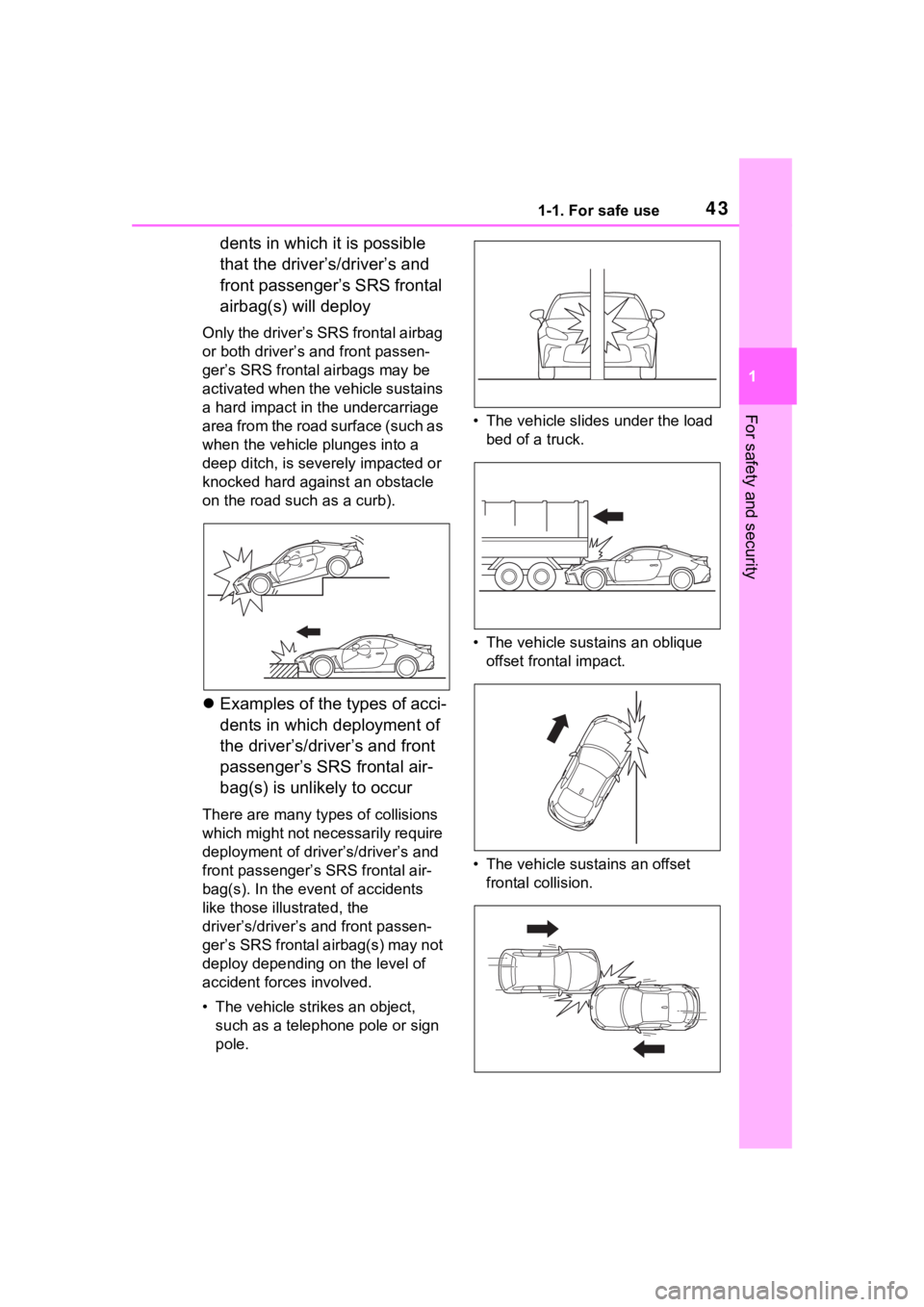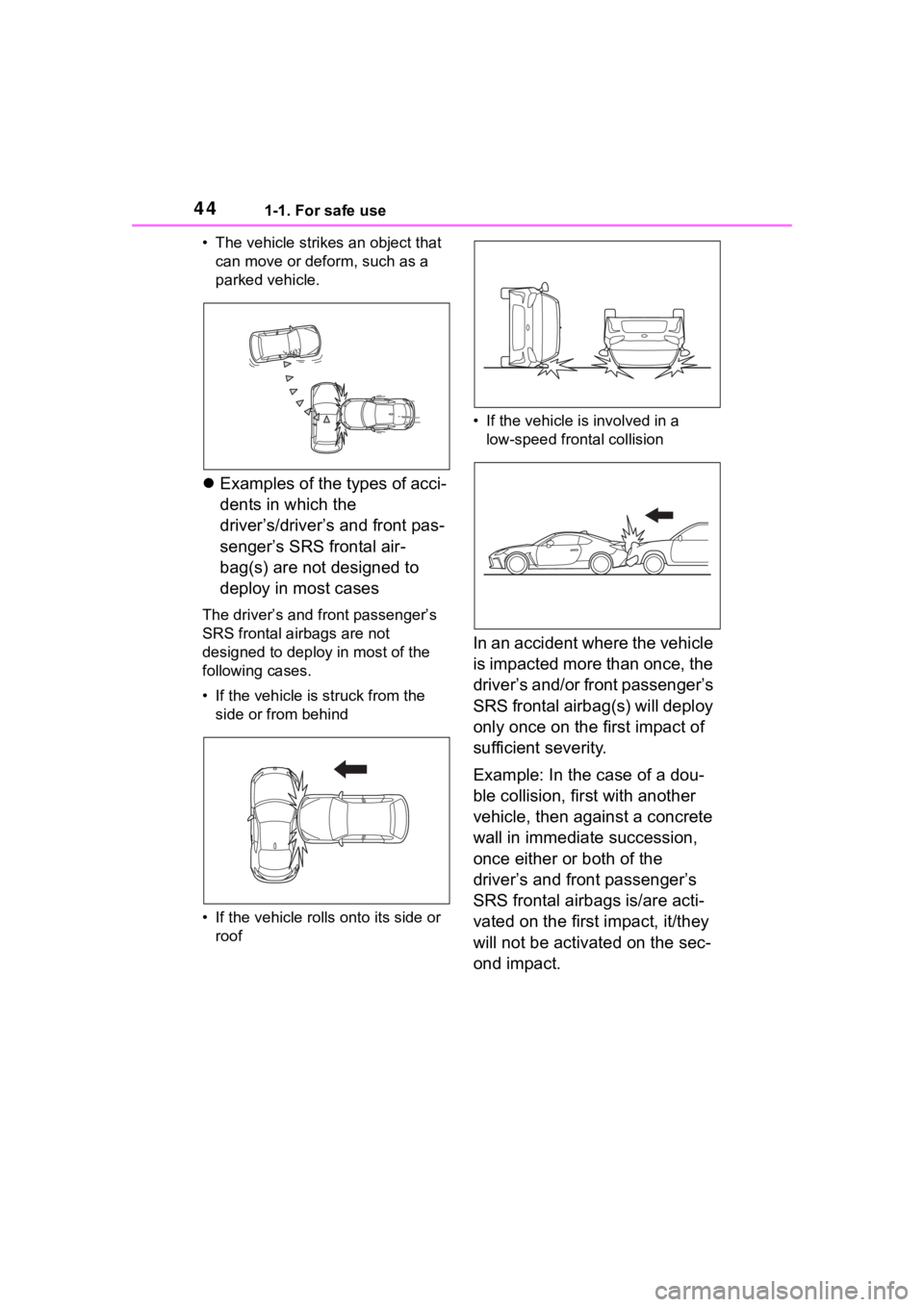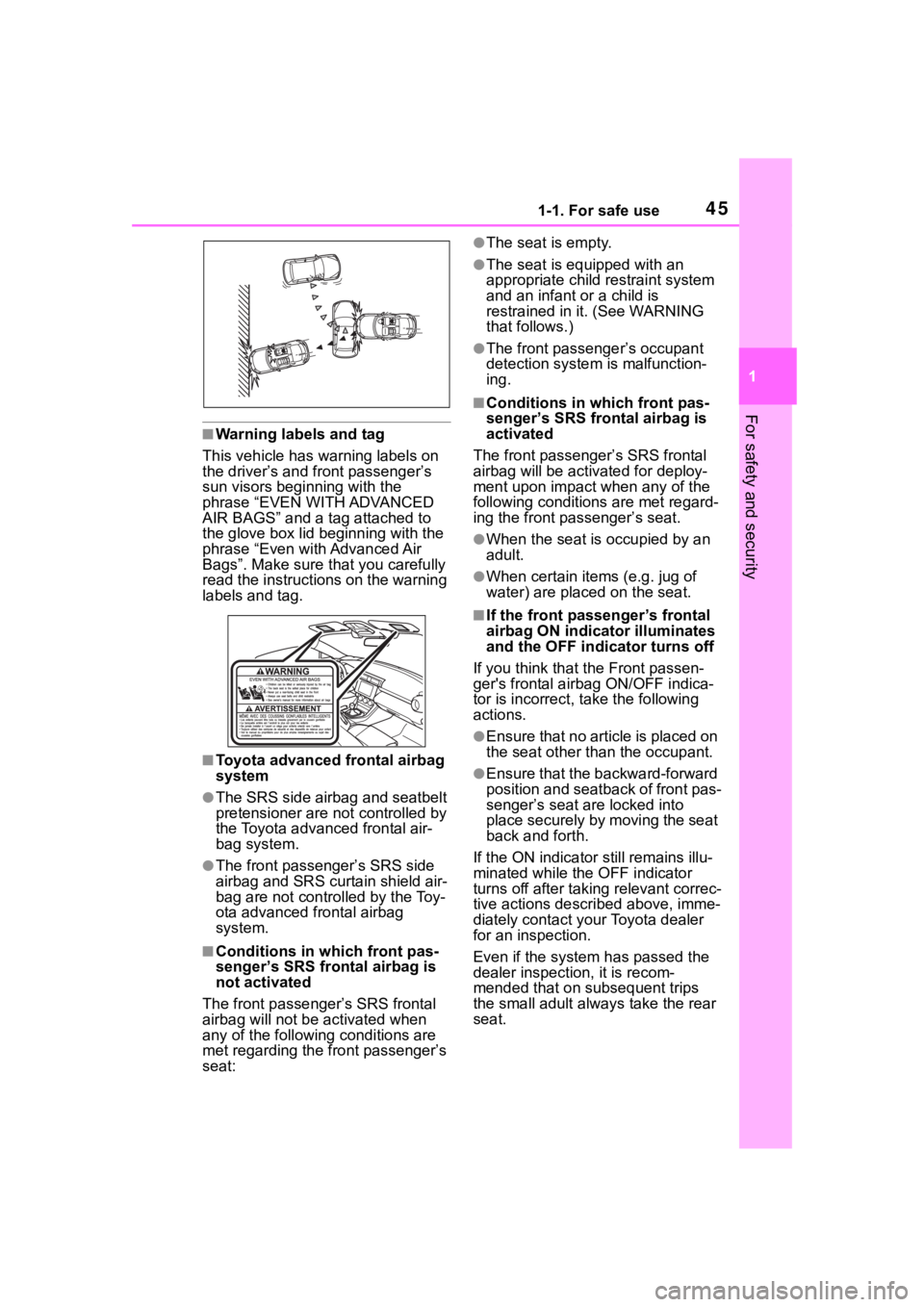2023 TOYOTA 86 airbag
[x] Cancel search: airbagPage 39 of 449

391-1. For safe use
1
For safety and security
This vehicle is equipped with a
Toyota advanced frontal airbag
system that complies with the
advanced frontal airbag require-
ments in the amended Federal
Motor Vehicle Safety Standard
(FMVSS) No. 208.
The Toyota advanced frontal air-
bag system automatically deter-
mines the deployment force of
the driver’s SRS frontal airbag at
the time of deployment as well
as whether or not to activate the
front passenger’s SRS frontal
airbag and, if activated, the
deployment force of the SRS
frontal airbag at the time of
deployment.
Always wear your seatbelt. The
Toyota advanced frontal airbag
system is a supplemental
restraint system and must be
used in combination with a seat-
belt. All occupants should wear
a seatbelt or be seated in an appropriate child restraint sys-
tem.
For the locations of the SRS air-
bags, refer to P.29.
In a moderate to severe frontal
collision, the following compo-
nents deploy.
SRS frontal airbag for driver
SRS frontal airbag for front
passenger
SRS curtain shield airbag
*
SRS knee airbag for driver
*: When an offset frontal collision
that is severe enough to deploy
the front airbag occurs.
These components supplement
the seatbelts by reducing the
impact to the occupant’s head,
chest and knees.
■Driver’s SRS frontal airbag
The driver’s SRS frontal airbag
uses a dual stage inflator. The
inflator operates in different
ways depending on the severity
of impact.
■Front passenger’s SRS
frontal airbag
The front passenger’s SRS fron-
tal airbag uses a dual stage
inflator. The inflator operates in
different ways depending on the
severity of impact.
■Occupant detection system
The occupant detection system
sensors are installed between
the seat and seat rails, and
NOTICE
• Between the rear seat cushion and rear wheel house on each
side
●In the event that the SRS airbag
is deployed, replacement of the
system should be performed
only by an auth orized Toyota
dealer. When the components
of the SRS airbag system are
replaced, use only genuine Toy-
ota parts.
Toyota Advanced Frontal
Airbag System
Page 40 of 449

401-1. For safe use
monitor the physique and pos-
ture of the front passenger.
Using this information, the occu-
pant detection system deter-
mines whether the front
passenger’s SRS frontal airbag
should be deployed or not.Occupant detection sensors
The occupant detection system
may not inflate the front passen-
ger’s SRS frontal airbag even
when the driver’s SRS frontal
airbag deploys. This is normal.
In this case, although the front
passenger’s SRS frontal airbag
does not operate, the front pas-
senger’s seatbelt pretensioner
operates with the driver’s seat-
belt pretensioner. For details
about the seatbelt pretensioner,
refer to P.27.
■Passenger’s frontal airbag
ON and OFF indicators
Refer to P.85. Front passenger’s frontal air-
bag OFF indicator
Front passenger’s frontal air-
bag ON indicator
■Operation
Driver’s side
SRS AIRBAGs deploy as
soon as a collision occurs.
After deployment, SRS AIR-
BAGs start to deflate immedi-
ately so that the driver’s
vision is not obstructed.
A
A
A
Page 41 of 449

411-1. For safe use
1
For safety and security
Passenger’s sideSRS AIRBAG deploy as soon
as a collision occurs.
After deployment, SRS AIR-
BAG start to deflate immedi-
ately so that the driver’s
vision is not obstructed.
The SRS airbags can function
only when the engine switch is
in ON.
The Toyota advanced frontal air-
bag system is designed to deter-
mine the activation or
deactivation condition of the
front passenger’s SRS frontal
airbag depending on the charac-
teristic of item(s) or person on
the front passenger’s seat moni-
tored by the front passenger’s
occupant detection system sen-
sor. For this reason, only the
driver’s SRS frontal airbag may
deploy in the event of a collision,
but this does not mean failure of
the system.
If the following sensors detect a predetermined amount of force
during a frontal collision, the
control module sends signals to
the airbag module(s) (only
driver’s module or both driver’s
and front passenger’s modules)
instructing the module(s) to
inflate the SRS frontal airbag(s).
The front impact sensors
The impact sensors in the air-
bag control module
On the driver’s side, the SRS
knee airbag also inflates with
the SRS frontal airbag.
The driver’s and front passen-
ger’s SRS frontal airbags use
dual stage inflators. The two
inflators of each airbag are trig-
gered either sequentially or
simultaneously, depending on
the severity of impact, in the
case of the driver’s SRS frontal
airbag and depending on the
severity of impact and the char-
acteristic of item(s) or person on
the seat in the case of the front
passenger’s SRS frontal airbag.
■After deployment
After deployment, the SRS air-
bag immediately starts to deflate
so that the driver’s vision is not
obstructed and the driver’s abil-
ity to maintain control of the
vehicle is not impaired. The time
required from detecting impact
to the deflation of the SRS air-
bag after deployment is shorter
than the blink of an eye.
A
Page 42 of 449

421-1. For safe use
Both when only the driver’s SRS
frontal airbag deploys and the
driver’s and front passenger’s
SRS frontal airbags deploy, the
driver’s and front passenger’s
seatbelt pretensioners operate
at the same time.
When the SRS airbag deploys,
a sudden, fairly loud inflation
noise will be heard and some
smoke will be released. These
occurrences are a normal result
of the deployment. This smoke
does not indicate a fire in the
vehicle.
■Example of the type of acci-
dent
The driver’s SRS frontal airbag
and front passenger’s SRS fron-
tal airbag are designed as fol-
lows.
To deploy in the event of an
accident involving a moderate
to severe frontal collision
To function on a one-time-only
basis
The driver’s SRS frontal airbag
and front passenger’s SRS fron-
tal airbag are not designed as
follows.
To deploy in most lesser fron-
tal impacts
*1
To deploy in most side or rear
impacts or in most rollover
accidents
*2
*1: Because the necessary protec-
tion can be achieved by the seat- belt alone.
*2: Because deployment of only the
driver’s SRS fron tal airbag or
both the driver’s and front pas-
senger’s SRS frontal airbags
would not protect the occupant in
those situations.
SRS airbag deployment
depends on the level of force
experienced in the passenger
compartment during a collision.
That level differs from one type
of collision to another, and it
may have no bearing on the vis-
ible damage done to the vehicle
itself.
Example of accident in which
the driver’s/driver’s and front
passenger’s SRS frontal air-
bag(s) will most likely deploy
A head-on collision against a thick
concrete wall at a vehicle speed of
12 to 19 mph (20 to 30 km/h) or
higher activates only the driver’s
SRS frontal airbag or both driver’s
and front passenger’s SRS frontal
airbags. The air bag(s) will also be
activated when the vehicle is
exposed to a front al impact similar
in fashion and magnitude to the col-
lision described above.
Examples of the types of acci-
Page 43 of 449

431-1. For safe use
1
For safety and security
dents in which it is possible
that the driver’s/driver’s and
front passenger’s SRS frontal
airbag(s) will deploy
Only the driver’s SRS frontal airbag
or both driver’s and front passen-
ger’s SRS frontal airbags may be
activated when the vehicle sustains
a hard impact in the undercarriage
area from the road surface (such as
when the vehicle plunges into a
deep ditch, is seve rely impacted or
knocked hard against an obstacle
on the road such as a curb).
Examples of the types of acci-
dents in which deployment of
the driver’s/driver’s and front
passenger’s SRS frontal air-
bag(s) is unlikely to occur
There are many types of collisions
which might not necessarily require
deployment of driver’s/driver’s and
front passenger’s SRS frontal air-
bag(s). In the eve nt of accidents
like those illu strated, the
driver’s/driver’s and front passen-
ger’s SRS frontal airbag(s) may not
deploy depending on the level of
accident forces involved.
• The vehicle strikes an object, such as a telephone pole or sign
pole. • The vehicle slides under the load
bed of a truck.
• The vehicle sustains an oblique offset frontal impact.
• The vehicle sustains an offset frontal collision.
Page 44 of 449

441-1. For safe use
• The vehicle strikes an object that can move or deform, such as a
parked vehicle.
Examples of the types of acci-
dents in which the
driver’s/driver’s and front pas-
senger’s SRS frontal air-
bag(s) are not designed to
deploy in most cases
The driver’s and front passenger’s
SRS frontal ai rbags are not
designed to deploy in most of the
following cases.
• If the vehicle is struck from the side or from behind
• If the vehicle rolls onto its side or
roof • If the vehicle is involved in a
low-speed fron tal collision
In an accident where the vehicle
is impacted more than once, the
driver’s and/or front passenger’s
SRS frontal airbag(s) will deploy
only once on the first impact of
sufficient severity.
Example: In the case of a dou-
ble collision, first with another
vehicle, then against a concrete
wall in immediate succession,
once either or both of the
driver’s and front passenger’s
SRS frontal airbags is/are acti-
vated on the first impact, it/they
will not be activated on the sec-
ond impact.
Page 45 of 449

451-1. For safe use
1
For safety and security
■Warning labels and tag
This vehicle has warning labels on
the driver’s and front passenger’s
sun visors beginning with the
phrase “EVEN WITH ADVANCED
AIR BAGS” and a tag attached to
the glove box lid beginning with the
phrase “Even with Advanced Air
Bags”. Make sure that you carefully
read the instructions on the warning
labels and tag.
■Toyota advanced frontal airbag
system
●The SRS side airbag and seatbelt
pretensioner are not controlled by
the Toyota advanced frontal air-
bag system.
●The front passenger’s SRS side
airbag and SRS curtain shield air-
bag are not controlled by the Toy-
ota advanced frontal airbag
system.
■Conditions in which front pas-
senger’s SRS frontal airbag is
not activated
The front passenger’s SRS frontal
airbag will not be activated when
any of the following conditions are
met regarding the front passenger’s
seat:
●The seat is empty.
●The seat is equipped with an
appropriate child restraint system
and an infant or a child is
restrained in i t. (See WARNING
that follows.)
●The front passenger’s occupant
detection system is malfunction-
ing.
■Conditions in which front pas-
senger’s SRS frontal airbag is
activated
The front passenge r’s SRS frontal
airbag will be activ ated for deploy-
ment upon impact when any of the
following conditions are met regard-
ing the front passenger’s seat.
●When the seat is occupied by an
adult.
●When certain items (e.g. jug of
water) are plac ed on the seat.
■If the front passenger’s frontal
airbag ON indicator illuminates
and the OFF indicator turns off
If you think that the Front passen-
ger's frontal airb ag ON/OFF indica-
tor is incorrect, take the following
actions.
●Ensure that no article is placed on
the seat other than the occupant.
●Ensure that the backward-forward
position and seatback of front pas-
senger’s seat are locked into
place securely by moving the seat
back and forth.
If the ON indicator still remains illu-
minated while the OFF indicator
turns off after taking relevant correc-
tive actions descr ibed above, imme-
diately contact your Toyota dealer
for an inspection.
Even if the system has passed the
dealer inspection, it is recom-
mended that on subsequent trips
the small adult alwa ys take the rear
seat.
Page 46 of 449

461-1. For safe use
■If the passenger’s frontal airbag
OFF indicator illuminates and
the ON indicator turns off even
when the front passenger’s seat
is occupied by an adult
This can be caused by the adult
incorrectly sitting in the front pas-
senger’s seat.
1 Turn the engine switch off.
2 Ask the front passenger to set
the seatback to the upright posi-
tion, sit up straight in the center
of the seat cushion, correctly fas-
ten the seatbelt, position his/her
legs out forward, and adjust the
seat to the rearmost position.
3 Turn the engine switch to ON.
If the OFF indicator remains illumi-
nated while the ON indicator
remains off, take the following
actions.
1 Turn the engine switch off.
2 Make sure that the front passen-
ger does not use a blanket, extra
seat cushion, sea t cover, extra
seat heater or massager, etc.
3 If wearing excessive layers of
clothing, the front passenger
should remove any unnecessary
items before sitting in the front
passenger’s seat, or should sit in
a rear seat.
4 Turn the engine switch to ON
and wait 6 seconds to allow the
system to complete self-check-
ing. Following the system check,
both indicators turn off for 2 sec-
onds. Now, the ON indicator
should illuminate while the OFF
indicator remains off.
If the OFF indicator still remains illu-
minated while the ON indicator
remains off, ask the occupant to
move to the rear seat and immedi-
ately contact your Toyota dealer for
an inspection.■If the seatbelt buckle switch
and/or front passenger’s occu-
pant detection system have
failed
If the seatbelt buckle switch and/or
front passenger’s occupant detec-
tion system have failed, the SRS
warning light will illuminate. Have
the system inspected by your Toyota
dealer immediately if the SRS warn-
ing light illuminates.
■When to contact your Toyota
dealer
If your vehicle has sustained impact,
this may affect the proper function of
the Toyota advanced frontal airbag
system. Have your vehicle
inspected at your Toyota dealer. Do
not use the front passenger’s seat
while driving the vehicle to your Toy-
ota dealer.
WARNING
■When using a child restraint
system
NEVER INSTALL A CHILD
RESTRAINT SYSTEM IN THE
FRONT PASSENGER’S SEAT
EVEN IF THE FRONT PASSEN-
GER’S SRS FRONTAL AIRBAG
IS DEACTIVATED. Be sure to
install it in the REAR seat in a cor-
rect manner. Also, it is strongly
recommended that any forward
facing child seat or booster seat
be installed in the REAR seat, and
that even children who have out-
grown a child restraint system be
also seated in the REAR seat.
This is because children sitting in
the front passenger’s seat may be
killed or severely injured should
the front passenger’s SRS frontal
airbag deploy. REAR seats are
the safest place for children.